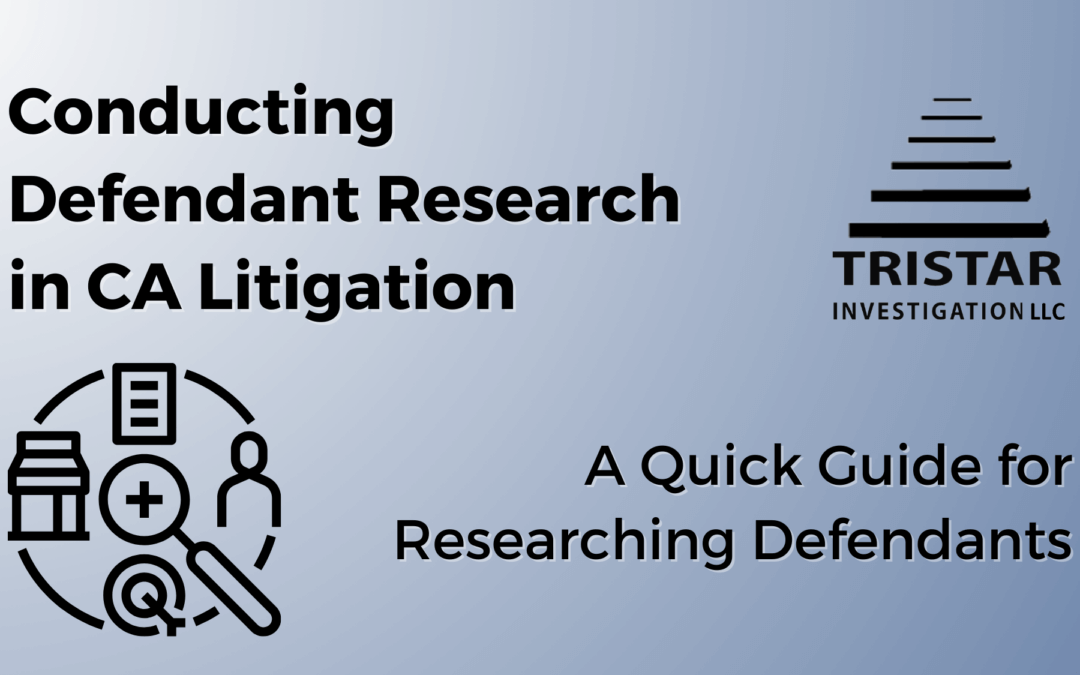A Quick Guide for California Law Firms
Researching labor and employment litigation defendants, especially in PAGA cases, has become increasingly complex. California companies have become much more challenging to investigate. This challenge is partly due to practices such as having various parts of a single business divided into multiple corporations or LLCs, incorporating via masked filing services without naming principles or the physical address, using Fictitious Business Filings to obscure the chain of ownership, and holding property ownerships in shell corporations or LLCs.
However, if you arm your staff with additional platforms and techniques, you can build a strong case against even the most entrenched civil defendants. My research team at Tristar Investigation has used all the methods below – and many more – in researching over 600 PAGA cases and thousands of other civil cases.
Revisit research basics in our quick guide: Overcome Employee Research Obstacles in Labor & Employment Cases.
The three major tasks when researching a defendant are: 1) determining the entity, 2) finding the owners, and 3), when necessary, determining the value of the business & its assets.
1) Determine the Entity
Identify the business’s ownership legal entity status to properly file your case, assess the defendant’s scope of operations and asset profile, and identify any potential co-defendants that should be named.
Always start with a California Secretary of State (SOS) search.
Are they a corporation, an LLC, a sole proprietorship, or perhaps part of a conglomerate?
Are there signs of a shell corporation?
How can you tell? Look for a “shielded content” filing with the California SOS, where no name or address is linked. Another red flag is when the partners or owners are other LLCs.
⭐️BONUS TIP⭐️
Run the company name through one of many available public records databases such as Crunchbase or Buzzfile. Tristar Investigation uses a reputable service based in Sacramento to manage the service of process for our company. But even the free version of Crunchbase provides enough clues to find our owner. Not that he’s hiding <wink>.
2) Find the Owners
Sometimes, you’ll get lucky, and all business owners and their current home addresses will be listed publicly on the SOS website.
However, most modern companies hire an ‘Agent of Service,’ which will minimize junk mail and legally keep anyone from finding the owner’s name and address in a public filing.
To make it harder, though they operate in the State of California, the parent entity may have incorporated outside of California (Delaware and Nevada are often used, for instance), sometimes for tax benefits and to gain court jurisdictions more favorable to corporations.
The SOS website includes several search types, including a UCC search. Start there. Google Searches and company website searches can yield“ fictitious business names,” aka FBNs. They are more commonly known as “doing business as” names or DBAs. They may also turn up “trade names,” which are not legal entities but monikers under which the company does business.
Look at our article on finding missing plaintiffs for additional search techniques.
⭐️BONUS TIP⭐️
When a company hides its owners, try pivoting from a first name + last name search to a physical address search. When you search for the full California address, you can find companies associated with it. Don’t forget to include quotes in Google Searches, e.g., “12030 W Washington Blvd #200, Los Angeles, CA 90066” and try variations, e.g., “12030 W Washington Blvd Suite #200, Los Angeles, CA 90066″.
3) Determine the Value of the Business and its Assets
There are plenty of databases available to (roughly) estimate the value of a business. However, calculating the accurate value of the company, including all of its assets, is a complicated process.
Check Dun & Bradstreet. D&B provides estimated valuations of millions of companies. Their data can get you in the right ballpark. Use caution, however, because this data is usually either “self-reported” or estimated via algorithms and not independently verified.
Review Paycheck Protection Program data. PPP loan amount data is public and can be used to extrapolate labor costs, from which you can broadly estimate revenue.
UCC Filings. California legally requires information on collateral pledged against debts to be publicly posted and digitally searchable. You could use this public data to get information on assets that are collateral and also identify their banking affiliations.
⚠️BONUS TIP⚠️
A word of caution for law firms! Relying solely on public data sources like Westlaw or Lexis Nexis for asset investigations can be misleading. Algorithms generate their valuations and rarely present a complete picture. For instance, when an asset is transferred to a trust, it’s often removed from the valuation equation.
Hire Tristar Investigation for Your Defendant Research
We’ve worked on thousands of defendant research projects across California. In addition to bringing decades of hard-earned expertise, our research team’s speed & precision is unmatched. And since hiring out defendant research to Tristar Investigation qualified as a Standard Recoverable Cost, you can keep your case costs in check.
Bruce Robertson
Latest posts by Bruce Robertson (see all)
- Accelerate Employee & Witness Outreach - Oct 30, 2023
- Overcome Employee Research Obstacles in Labor & Employment Cases - Oct 25, 2023
- Advice on Conducting Defendant Research in California Litigation - Oct 11, 2023


